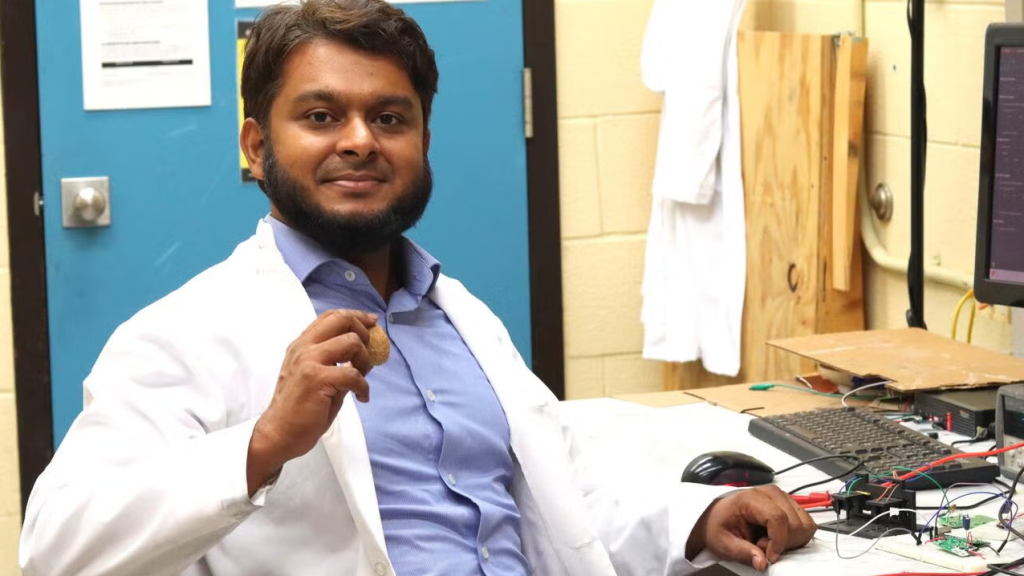Science
Researchers Turn Walnut Shells and Water into Innovative Energy Source

Researchers at the University of Waterloo have developed a groundbreaking method to generate electricity using discarded walnut shells and just a drop of water. This innovative approach harnesses the unique properties of walnut shells to transport electrically charged ions, creating a new electric generator known as the water-induced electric generator (WEG).
The concept emerged when Nazmul Hossain, a PhD student in mechanical and mechatronics engineering, examined the internal structures of nut shells under an electron microscope. This exploration was sparked by a seemingly simple act—eating a hazelnut and investigating its shell. The intricate architecture of the shells proved to be highly effective in facilitating water and nutrient transport, leading to the discovery that evaporating water within these porous structures can produce electricity.
This hydrovoltaic energy harvesting technique relies on the natural properties of walnut shells without the need for crushing, soaking, or complex processing. Hossain emphasized the simplicity and effectiveness of the method: “It’s a simple, yet powerful example of turning waste into clean energy using nature’s own power.”
Potential Applications of Water-Induced Electric Generators
The WEG is compact, roughly the size of a coin, and consists of walnut shells, water droplets, electrodes, wires, and a 3D-printed base. Researchers believe this technology could significantly impact how small electronic devices are powered, especially in remote or off-grid locations. Hossain noted, “Imagine environmental sensors monitoring forests, IoT and wearable health devices, disaster-relief equipment, all running on tiny water droplets from the air.”
Initial tests involved various nut shells, with walnut shells showing the most promise for energy production. As the research progresses, the next steps include developing the technology into a wearable device that could harvest sweat or rain. This advancement could lead to new methods for powering various small devices and sensors, potentially even detecting water leaks.
The work at the University of Waterloo is part of a broader trend in innovative technological developments that emphasize sustainability and efficiency. By leveraging natural materials and processes, researchers are paving the way for cleaner energy solutions that could benefit communities worldwide.
Hossain’s findings not only highlight the potential of utilizing waste materials but also open doors to numerous applications in the field of energy generation. As the project moves forward, the implications for both environmental sustainability and technological advancement appear promising.
-

 Education3 months ago
Education3 months agoBrandon University’s Failed $5 Million Project Sparks Oversight Review
-

 Science4 months ago
Science4 months agoMicrosoft Confirms U.S. Law Overrules Canadian Data Sovereignty
-

 Lifestyle3 months ago
Lifestyle3 months agoWinnipeg Celebrates Culinary Creativity During Le Burger Week 2025
-

 Health4 months ago
Health4 months agoMontreal’s Groupe Marcelle Leads Canadian Cosmetic Industry Growth
-

 Science4 months ago
Science4 months agoTech Innovator Amandipp Singh Transforms Hiring for Disabled
-

 Technology3 months ago
Technology3 months agoDragon Ball: Sparking! Zero Launching on Switch and Switch 2 This November
-

 Education3 months ago
Education3 months agoRed River College Launches New Programs to Address Industry Needs
-

 Technology4 months ago
Technology4 months agoGoogle Pixel 10 Pro Fold Specs Unveiled Ahead of Launch
-

 Business3 months ago
Business3 months agoRocket Lab Reports Strong Q2 2025 Revenue Growth and Future Plans
-

 Technology2 months ago
Technology2 months agoDiscord Faces Serious Security Breach Affecting Millions
-

 Education3 months ago
Education3 months agoAlberta Teachers’ Strike: Potential Impacts on Students and Families
-

 Science3 months ago
Science3 months agoChina’s Wukong Spacesuit Sets New Standard for AI in Space
-

 Education3 months ago
Education3 months agoNew SĆIȺNEW̱ SṮEȽIṮḴEȽ Elementary Opens in Langford for 2025/2026 Year
-

 Technology4 months ago
Technology4 months agoWorld of Warcraft Players Buzz Over 19-Quest Bee Challenge
-

 Business4 months ago
Business4 months agoNew Estimates Reveal ChatGPT-5 Energy Use Could Soar
-

 Business3 months ago
Business3 months agoDawson City Residents Rally Around Buy Canadian Movement
-

 Technology2 months ago
Technology2 months agoHuawei MatePad 12X Redefines Tablet Experience for Professionals
-

 Business3 months ago
Business3 months agoBNA Brewing to Open New Bowling Alley in Downtown Penticton
-

 Technology4 months ago
Technology4 months agoFuture Entertainment Launches DDoD with Gameplay Trailer Showcase
-

 Technology4 months ago
Technology4 months agoGlobal Launch of Ragnarok M: Classic Set for September 3, 2025
-

 Technology4 months ago
Technology4 months agoInnovative 140W GaN Travel Adapter Combines Power and Convenience
-

 Science4 months ago
Science4 months agoXi Labs Innovates with New AI Operating System Set for 2025 Launch
-

 Technology4 months ago
Technology4 months agoNew IDR01 Smart Ring Offers Advanced Sports Tracking for $169
-

 Top Stories2 months ago
Top Stories2 months agoBlue Jays Shift José Berríos to Bullpen Ahead of Playoffs










